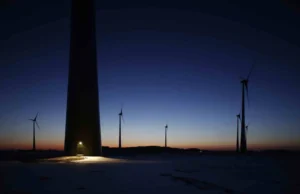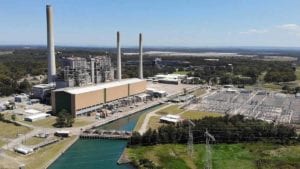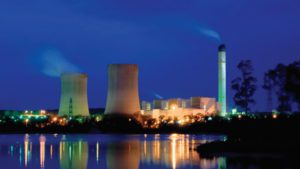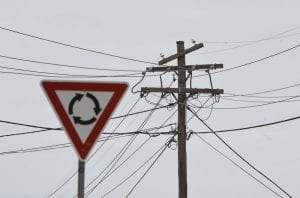AGL Energy has hinted at an early closure of its fossil fuel fleet that would bring it in line with scenarios consistent with the Paris 1.5°C climate target, even as the company also works to manage its ageing coal plants to shore up electricity supplies in the coming summer.
The possibility of early closures was revealed at the company’s annual general meeting on Thursday, where – under pressure from shareholder activists on one side and the jaw-boning from the government on the other – chairman Graeme Hunt said the company intends to “analyse” and “understand” what the impacts would be of meeting the 1.5°C target.
This is significant, because under the current AGL timeline, it proposes to keep some of its coal assets open until at least 2048, which scientists say will not fit into the carbon budget allowable for a 1.5°C outcome, which at current rates of pollution could be exhausted in little more than a decade.
The Australian Energy Market Operator is considering a similar 1.5°C outcome in the next stage of its Integrated System Plan, at the urging – it should be noted – of big energy companies such as AGL.
Hunt’s admission came as AGL found itself caught between competing pressures; shareholders and environmental advocates on one side who see the operation of AGL’s substantial fleet of coal-fired generators as inconsistent with climate action, and the federal government which is demanding the company keep its coal-fired power stations operating.
Energy minister Angus Taylor, who is opposed to the proposed closure of Liddell in 2023, and wants all coal generators to “stay on line and run at full tilt” wrote on Thursday that energy companies “must not “capitulate to the demands from the green left to prematurely close down coal and gas generators’.”
At the AGM, the AGL board received a flurry of questions from shareholders about the company’s plans to reduce its greenhouse gas emissions, based on both an environmental imperative to reduce greenhouse gas emissions and potential threats to business operations created by an ageing coal power station fleet that is becoming increasingly unreliable.
Shareholders considered two resolutions put forward by shareholder activists, including from advocates Market Forces, that sought to push AGL to undertake greater assessment and disclosure of the company’s greenhouse gas emissions and the public health risks related to the company’s coal assets.
The board opposed the motions, which ensured that the motions failed to receive sufficient support, but the results of the votes indicated a growing view amongst shareholders that AGL must accelerate its plans for a transition away from fossil fuels and to account for the public health impacts of coal.
A motion that called on AGL to “disclose strategies to reduce scope 1 and 2 emissions in line with the climate goals of the Paris Agreement”, with such plans consistent with a phasing out of coal by 2030, received a vote in support of just over 31%. AGL currently has a plan to close all of its coal-fired generators by 2050.
A second motion, requesting that “the board prepare and disclose an assessment of the capital and operating expenditure required to install and maintain pollution controls at the Bayswater and Loy Yang A coal-fired power stations” received support from just over 11% of shareholders.
While the board did not support the motions, Hunt told the AGM that AGL would be developing future business scenarios that would allow AGL to undertake the closure of its fossil-fuelled generator fleet in line with Paris Agreement goals.
“During the 2020 financial year, we intend to undertake further analysis to understand the impacts on AGL’s portfolio and closure plans under scenarios that limit warming to below 1.5 degrees above pre-industrial levels,” Hunt said.
AGL ranks as Australia’s largest emitter of greenhouse gases, by virtue of the company’s ownership of three of Australia’s top 10 emitting power stations, being Loy Yang (ranked first), Baywater power station (ranked third) and Liddell power station (ranked eighth).
The AGL board was keen to impress on shareholders that it remains focused on transitioning the business in the midst of an energy sector undergoing a fundamental transition to cleaner sources of electricity generation.
AGL appears to remain committed to the decommissioning of the Liddell power station by 2023, following a revised timeline after it announced a delay to its closure in response to pressure to keep the ageing coal-fired power station open to sure up supply during the summer period.
AGL CEO Brett Redman said that he believed it was crucial that the Federal government put in place policy mechanisms that would support new investment in the generation sector, and that AGL believes that any such new investment would naturally be lower emissions technologies.
“I’m less worried about mechanisms that go to carbon emissions, because I’m a firm believer that technology means that old generation closes and new generation is built, it’s moving to a lower carbon setting. I’m more interested, therefore, in policy settings that will get new plant built,” Redman said.
“Liddell’s first unit will close in April 2022 and the remaining three units will close in April 2023. By this date, and after 50 years of operation, Liddell will have well and truly reached the end of its technical life,” AGL CEO Brett Redman said
AGL will also delay the mothballing of the Torrens A power station in South Australia as the company seeks to mitigate the impacts of the ongoing outage of Unit 2 at the Loy Yang power station which was caused by an electrical short within the generator unit.
This week it had three of the four Loy Yang units out of service, one for scheduled maintenance, and two for unexpected issues. One unit is due to return on Friday.
AGL still expects the Loy Yang unit to remain offline until mid-December as repairs are undertaken and the company expects the loss of generation from the Loy Yang unit to result in a negative impact to company profits of between $80 and $100 million in the 2019/20 financial year.
Further outages have impacted two additional units, leaving Loy Yang currently operating on a single generator unit, but the company expects these units to be back up and running by the end of the week.
AGL was also confident that the challenges emerging from new marginal loss factors, which have substantially impacted revenues of projects on the outer edges of the National Electricity Market, would be addressed in the near future. This includes AGL’s Broken Hill solar farm which copped a 22 per cent reduction in its marginal loss factor, directly flowing through to reduced revenues.
“The national grid is clearly struggling with the installation of renewables at the extremes of the grid”, Hunt said.
AGL believes that energy regulators will be able to develop a suitable solution to the marginal loss factor issues in the near future.
“We don’t see this will be a significant ongoing issue, but that will depend the National Electricity Market running appropriately, and that the right kind of investment is made in poles and wires and associated equipment to ensure it can be managed,” Hunt added.










